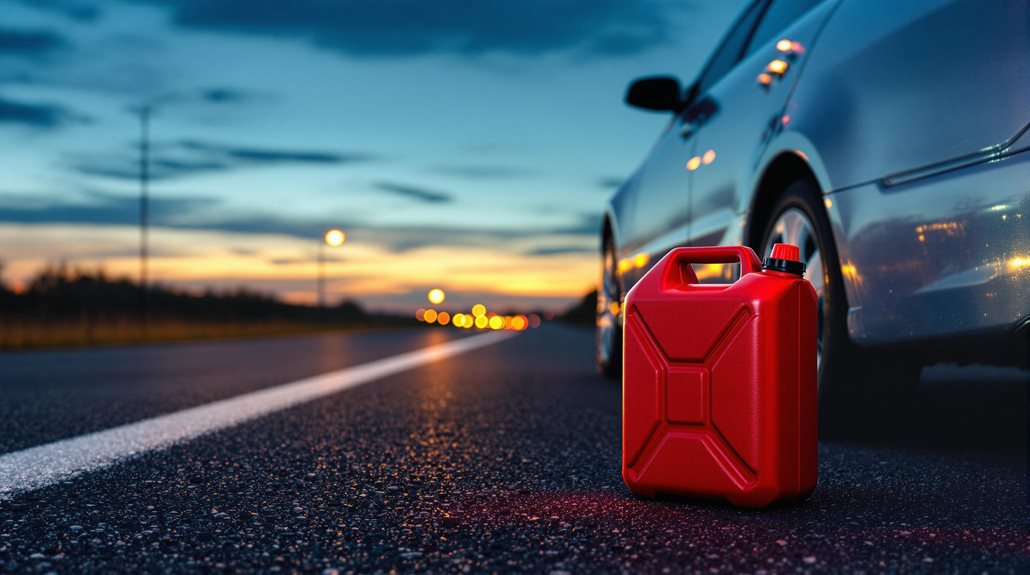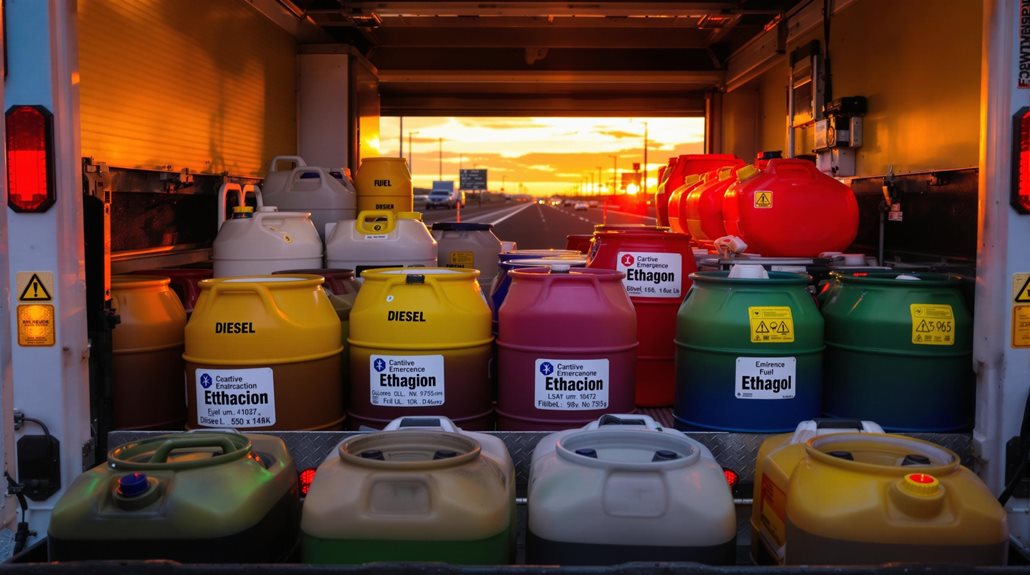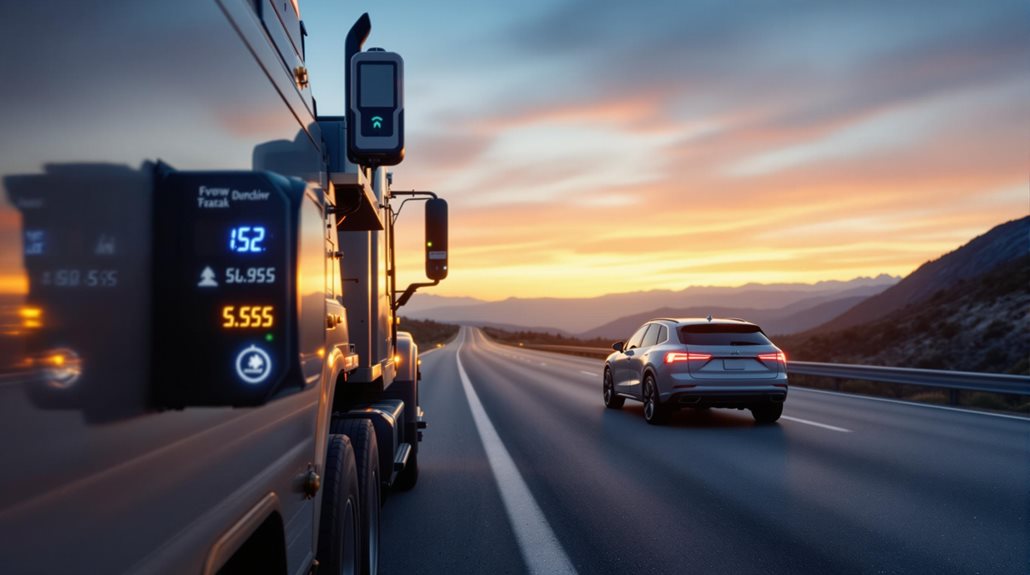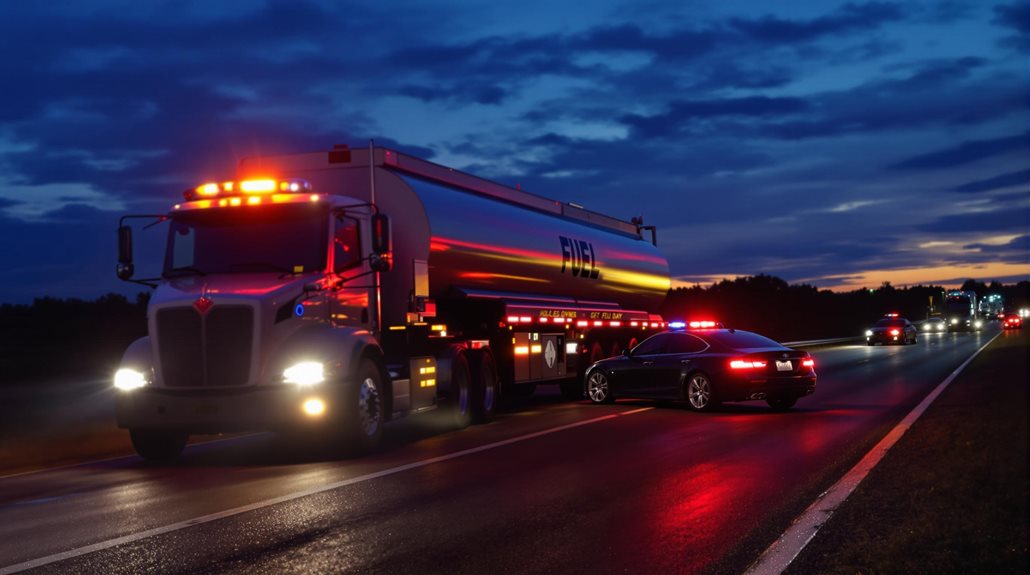Fuel delivery services provide essential roadside assistance to stranded motorists who have run out of gas. Professional technicians deliver various fuel types, including gasoline, diesel, and specialty fuels, typically within 30 minutes of receiving a call. These services operate across defined geographic boundaries, from urban centers to remote locations, ensuring extensive coverage throughout their service areas. Qualified providers maintain specialized equipment and safety protocols while offering competitive pricing for emergency fuel delivery. When requesting assistance, customers must provide accurate vehicle information and location details to receive prompt service. Understanding the full scope of these services reveals additional valuable benefits for motorists.
Expert Highlights
- Fuel delivery services provide emergency roadside assistance by bringing various fuel types directly to stranded vehicles within 30 minutes.
- Qualified technicians ensure safe delivery of compatible fuel types including gasoline, diesel, biodiesel, propane, and kerosene.
- Services operate within defined geographic boundaries, from local city centers to nationwide coverage, ensuring reliable response times.
- Customers can receive fuel at diverse locations including highways, homes, workplaces, and parking facilities across multiple counties.
- Emergency fuel assistance requires specific vehicle details and proper safety measures while waiting for the service provider.
What Are Fuel Delivery Services

Fuel delivery services are specialized roadside assistance solutions that bring fuel directly to stranded motorists who have run out of gas. These extensive services provide various fuel types, including petroleum gas, diesel, biodiesel, propane, kerosene, and specialty liquids, ensuring compatibility with different vehicle requirements. Professional qualified technicians deliver and handle all fuel types safely and efficiently. Our technicians complete each delivery in under 30 minutes to get you back on the road quickly.
Operating 24/7, these services prioritize rapid response times and seamless delivery processes through digital platforms that enable real-time tracking and updates. Customers can request assistance without requiring memberships, though some providers offer enhanced benefits through programs like AAA. In Minnesota, fuel delivery services are supported by a wide service area network, ensuring coverage in both urban and rural locations.
The service operates on a transparent pricing model, delivering fuel directly to vehicles regardless of location, eliminating the need for towing or searching for nearby gas stations. This efficient system helps motorists quickly resume their journeys while maintaining competitive, straightforward pricing structures.
Service Areas and Coverage
Roadside assistance providers establish distinct geographic boundaries for their fuel delivery services, with companies like DRIVE Roadside focusing on New York City and its boroughs, while others such as AAA Central Penn cover multiple counties across Pennsylvania and beyond.
The flexibility of delivery locations varies among providers, though most companies will bring fuel to stranded vehicles whether they're on highways, at homes, or in commercial areas. Companies provide comprehensive same-day gasoline delivery to ensure quick response times for customers in need. In New Jersey, customers can expect rapid response times with average arrival times of 35-45 minutes. Roadside assistance frequently includes a range of emergency services, covering fuel delivery, vehicle lockouts, towing, and flat tire changes.
While urban centers typically enjoy extensive coverage from multiple providers, the availability of fuel delivery services in suburban and rural areas may depend on specific companies' service territories and membership requirements.
Geographic Service Boundaries
Service providers establish distinct geographic boundaries that define where they can effectively deliver fuel to stranded motorists. The coverage areas vary greatly among providers, ranging from nationwide networks to localized services. Roadside assistance providers help eliminate the need for stranded motorists to seek out nearby gas stations.
While AAA and Urgently maintain comprehensive nationwide coverage, regional providers like R.A.P.A. and Mr.QuickPick focus on specific metropolitan areas, particularly Indianapolis and its surrounding regions.
Key distinctions in geographic coverage include:
- National providers offer seamless service across state lines, including remote areas
- Regional operators concentrate on specific metropolitan areas with extended radius options
- Local providers typically service city centers with surcharges for outlying areas
These established boundaries guarantee reliable response times and maintain service quality while balancing operational efficiency with customer needs across diverse geographic locations.
Delivery Location Flexibility
The extensive reach of modern fuel delivery extends far beyond traditional service zones, encompassing urban centers, suburban regions, and remote locations. Service coverage spans across major metropolitan areas like Manhattan and Brooklyn, while extending into suburban territories such as Westchester and Rockland counties, guaranteeing all-inclusive support for residents throughout the region.
The service network strategically covers diverse locations across New Jersey, including Bergen, Passaic, and Essex counties, with specialized attention to local neighborhoods like Lodi and Saddle Brook. This extensive coverage enables providers to deliver fuel efficiently to various settings, from highways and residential areas to workplace locations and parking facilities. The comprehensive geographic reach ensures that whether stranded on a remote road or requiring assistance in an urban center, reliable fuel delivery services remain readily accessible.
Types of Available Fuel

Three primary types of fuel are commonly available through roadside assistance delivery services: gasoline, diesel, and alternative fuels. Service providers understand the critical importance of delivering the correct fuel type that aligns with your vehicle's specific requirements, including appropriate octane ratings for gasoline-powered vehicles. Most roadside assistance programs offer: – Standard gasoline delivery with multiple octane options – Diesel fuel for trucks, heavy-duty vehicles, and diesel-powered passenger cars – Alternative fuel options in select service areas, subject to availability. The delivery amount typically provides enough fuel to reach the nearest service station, with providers carefully verifying fuel compatibility before service. Vehicle manufacturers' specifications and fuel system requirements are strictly adhered to, ensuring the safe and appropriate fueling of your vehicle during emergency situations. For comprehensive roadside assistance in emergencies, 24/7 car jump start and fuel delivery services are available throughout the Twin Cities region.
Requesting Emergency Fuel Assistance
Successfully requesting emergency fuel assistance requires understanding the proper procedures and essential information needed by service providers. When contacting roadside assistance, customers must provide accurate details about their vehicle's location, make, model, and specific fuel requirements, particularly for diesel engines that may need system bleeding. Safety remains paramount during the process, with drivers advised to activate hazard lights and position their vehicle safely on the roadside while awaiting assistance. The service provider will dispatch a specialized fuel delivery vehicle equipped with the necessary supplies. During the service call, technicians will deliver sufficient fuel to reach the nearest gas station and may offer additional support, such as vehicle restart assistance, ensuring motorists can continue their journey safely and efficiently. Additionally, many providers offer competitive pricing to ensure that the cost of emergency fuel delivery remains affordable for all customers.
Pricing and Payment Options

Understanding fuel delivery pricing involves multiple cost factors and payment structures that vary greatly among service providers. Service costs typically range from $50 to $100, with membership programs offering significant savings through tiered benefits. AAA members, particularly those with Plus, Plus RV, or Premier status, receive complimentary fuel delivery services, while Basic members pay only market rate for fuel.
Key pricing considerations include:
- Location-based variations, with rural areas often incurring higher costs due to extended travel distances
- Time-of-day differentials, where peak hours may command premium rates
- Membership level benefits, which can eliminate delivery fees and provide fuel at market rates
Another benefit of professional service includes access to additional services like towing or tire changes, which ensures a hassle-free experience for customers in need of roadside assistance.
Annual membership fees for roadside assistance programs range from $36 to $360, offering various coverage levels and payment structures to accommodate different budgets and service needs.
Benefits of Mobile Fuel Delivery
Mobile fuel delivery services provide critical safety benefits during emergencies by eliminating the need for stranded motorists to seek assistance in potentially dangerous conditions or locations.
The service's cost-efficient approach combines optimized delivery routes with reduced individual trips to gas stations, resulting in both economic and environmental advantages for customers and businesses alike.
These services prove particularly valuable during natural disasters or severe weather events, when traditional fuel stations may be inaccessible or non-operational, ensuring essential vehicles maintain their mobility and operations.
In Dinkytown, MN, with its vibrant energy for Gopher fans, roadside assistance services like mobile fuel delivery can provide peace of mind for both residents and the many students frequenting the University of Minnesota's nearby campus.
Safety During Emergencies
During emergency situations, roadside fuel delivery services play an essential role in maintaining safety and security for stranded motorists. These services provide critical support when traditional refueling options become inaccessible or hazardous, particularly during natural disasters, severe weather conditions, or other crisis scenarios.
Mobile fuel delivery services enhance emergency response capabilities through:
- Elimination of unnecessary exposure to dangerous weather conditions or traffic hazards
- 24/7 availability guarantees assistance regardless of time or location
- Direct-to-vehicle delivery minimizes risk of theft or vehicle damage
The implementation of professional fuel delivery services substantially reduces the likelihood of vehicle-related incidents during emergencies. By providing a reliable alternative to traditional gas station visits, these services make certain that motorists can maintain their safety while receiving the fuel assistance they require, particularly in remote locations or during challenging circumstances.
Cost-Efficient Fuel Solutions
Modern fuel delivery services offer four distinct cost advantages that make them an increasingly attractive option for both individual motorists and fleet operators. Companies can achieve significant savings through eliminated fuel waste from station trips, protection against credit card fraud commonly found at public pumps, and the absence of recurring subscription fees. These services operate on a pay-per-use model, ensuring customers only incur costs when necessary.
| Cost Factor | Traditional Fueling | Mobile Delivery |
|---|---|---|
| Time Investment | High (Station Visits) | Minimal |
| Security Risk | Significant | Negligible |
| Hidden Fees | Common | None |
The competitive pricing structure of mobile fuel delivery, combined with transparent pricing and no hidden charges, provides a cost-efficient solution that aligns with both individual and commercial fueling needs. This efficiency translates to measurable annual savings, particularly for businesses managing vehicle fleets.
Customer Support and Response Times

Professional roadside assistance providers step up to deliver thorough customer support through multiple channels, guaranteeing drivers can easily access fuel delivery services when needed. Leading companies like AAA and Allstate have implemented comprehensive support systems with round-the-clock availability and rapid response protocols.
Key support channels include:
- 24/7 phone support for emergency fuel delivery situations
- Mobile applications offering streamlined service requests and real-time tracking
- Online portals and virtual assistants for efficient service coordination
These providers maintain robust response systems designed to minimize wait times, with some companies promising arrival within 30 minutes. The multi-channel approach, combined with efficient dispatch protocols, guarantees that stranded motorists receive prompt assistance regardless of their location or the time of day, demonstrating the industry's commitment to reliable service delivery.
Roadside Assistance FAQ
How Much Extra Fuel Can Be Delivered Beyond What My Tank Holds?
Fuel delivery services cannot provide more fuel than your vehicle's tank capacity. The standard 3-gallon emergency delivery is designed to safely get you to the nearest gas station.
Can Fuel Be Delivered to a Boat or Recreational Vehicle?
Most roadside fuel delivery services are limited to land-based vehicles on accessible roads. Boats typically require marina services, while recreational vehicles can receive fuel if they're reachable by delivery trucks.
What Happens if the Wrong Type of Fuel Is Accidentally Delivered?
If wrong fuel is delivered, shut down the vehicle immediately to prevent engine damage. Professional draining and system flushing will be required, along with possible repairs to fuel components.
Are There Additional Charges for Fuel Delivery During Major Weather Events?
Most fuel delivery services maintain standard pricing during major weather events, focusing on reliable service without additional charges. Our commitment is to support customers consistently through all conditions.
Do I Need to Be Present When the Fuel Is Delivered?
While not strictly required, being present can expedite the delivery process. If you can't be there, provide clear access instructions and vehicle details to facilitate successful fuel delivery.
